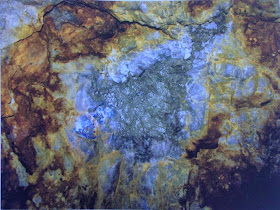Bonnie and Steve Shaffer pose with Scott after shooting a scene.
It gets pretty crowded sometimes shooting close-ups; especially tight on the ledge of a cliff!
The cave system at this secret location looked like it certainly could have been a repository for Montezuma's treasure at one time. It was remote, had all the signs of a repository and was dangerous.
This seemingly bottomless shaft was one of at least three bobby-traps in the cave system. If one fell into this hole, you wouldn't come out of it alive.
Everything was thumb's up at the start of the dive. Unfortunately, things went downhill once we submerged.
This episode was perhaps the most interesting "treasure hunt" I've been on so far. The legendary stories are always interesting, but I started really getting excited when I visited the cave system in the mountains that were definitely man-made and had all the makings of a secret repository. Since legend had it that Freddie Crystal was in this area, and the workings in the cave system appeared to be over a century old, I thought we were really onto something. Looking up at the entrance from roughly a mile away, what I originally thought were natural caves at a distance, turned to out to much more interesting up close. The wind eroded natural caves had definitely been extensively enhanced by man. The question I kept asking was, "Why would someone put so much effort into a cave system that is so remote?" Local Natives certainly could have been responsible, but if so, why the need for at least three booby traps pits, including one that went down as far as a flashlight could shine?
The cave system also included a large pit that could have been filled and then covered over to conceal its contents. Those contents could certainly have been a large cache of gold and other valuables. Since the likely repository was now empty, that meant whatever was in there had been moved. It seemed that all indicators pointed to Lonn's property and the tunnel system below the pond. this of course led to one of the most interesting and spooky dives I've ever done.
As I said in the show, I'm not big on curses and believe people make things worse for themselves with mind games. Maybe that's why curses work; if you believe something is true, you're halfway there. Before the final dive after three hours of being in the water, one of our divers got hypothermia and had to get out. That left me and two safety divers, one handling the underwater camera. Once we reached the entrance to the underwater tunnel, the third diver couldn't enter and waited at the entrance. Keep in mind the entrance at the base of the overhanging cliff was at 35 feet underwater. Because the rocks were angled outward overhead, I could watch my air bubbles rise along the rock which allowed me to keep my bearings. As I entered the tunnel the roof angled down to the point I had to crawl on my knees. Moving in I kept one eye on my bubbles knowing they were rising in the direction of my exit. The diver carrying the camera and lights stopped just inside the cave as tunnel got too low and narrow for him to enter. I kept going in and the diver's lights behind me got dimmer in the sediment-filled water and when it was almost pitch black I paused and turned on my own flashlight.
At this point, the tunnel beckoned me to go forward and just as I was about to press on, I glanced at the rock ceiling inches above my head. My air bubbles were no longer moving up and out. They were coalescing and then slowly moving outward in BOTH directions. I then turned around and saw a slight glimmer of the diver's lights and knew this was my only way to get out. To go any further would have been foolish. The lure of finding whatever was at the end of this tunnel wasn't worth the risk, so headed back toward that light and followed the rock wall back to the surface.
Once back on shore, I truly was cold, tired and a little disappointed in myself that I let the lure of treasure put me in a potentially dangerous situation. To top it all off, to not be able to do the safest and easiest thing, drain the pond, was especially frustrating. In a way though, it was fitting. If Montezuma's treasure really is inside that tunnel in a cave under the pond, how ironic it's being guarded by a snail.



















